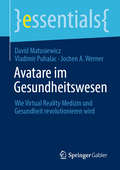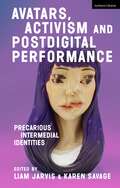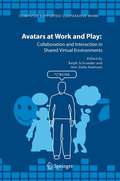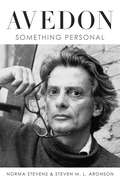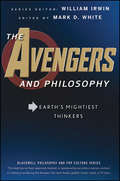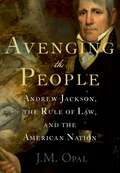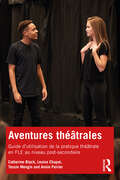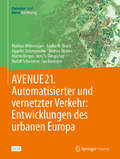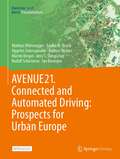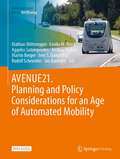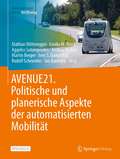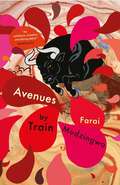- Table View
- List View
Avatare im Gesundheitswesen: Wie Virtual Reality Medizin und Gesundheit revolutionieren wird (essentials)
by David Matusiewicz Vladimir Puhalac Jochen A. WernerIn Zukunft werden wir mit unserem eigenen Avatar mit dem behandelnden Arzt im Smart Hospital sprechen können – und das vom Wohnzimmer aus. Das klingt utopisch, ist allerdings schon Realität geworden. Das essential beschäftigt sich mit der Frage, welchen Effekt Virtual Reality und die Avatare im Gesundheitswesen, der Medizin und in der Psychologie haben werden. Durch die praktische Erfahrung der Autoren können tiefgreifende Einblicke in eine exponentielle Technologie gegeben werden.
Avatars, Activism and Postdigital Performance: Precarious Intermedial Identities
by Liam Jarvis Karen SavageIn the context of the postdigital age, where technology is increasingly part of our social and political world, Avatars, Activism and Postdigital Performance traces how identity can be created, developed, hijacked, manipulated, sabotaged and explored through performance in postdigital cultures. Considering how technology is reshaping performance, this timely collection reveals how we engage in performance practices through expanded notions of intermediality, knotted networks and layering.This book examines the artist as activist and producer of avatars, and how digital doubles, artificial intelligence and semi-automated politics are problematizing and expanding our discussions of identity. Using a range of examples in theatre, film and internet-based performance practices, chapters examine the uncertain boundaries of networked 'informational selves' in mediatized cultures, the impacts of machine algorithms, apps and the consequences of digital legacies. Case studies include James Cameron's Avatar, Blast Theory's Karen, Ontroerend Goed's A Game of You, Randy Rainbow's online videos, Sisters Grimm's Calpurnia Descending, Dante or Die's User Not Found, Dead Centre's Lippy and Chekhov's First Play and Jo Scott's practice-as-research in 'place-mixing'.This is an incisive study for scholars, students and practitioners interested in the wider conversations around identity-formation in postdigital cultures.
Avatars, Activism and Postdigital Performance: Precarious Intermedial Identities
by Liam Jarvis and Karen SavageIn the context of the postdigital age, where technology is increasingly part of our social and political world, Avatars, Activism and Postdigital Performance traces how identity can be created, developed, hijacked, manipulated, sabotaged and explored through performance in postdigital cultures. Considering how technology is reshaping performance, this timely collection reveals how we engage in performance practices through expanded notions of intermediality, knotted networks and layering.This book examines the artist as activist and producer of avatars, and how digital doubles, artificial intelligence and semi-automated politics are problematizing and expanding our discussions of identity. Using a range of examples in theatre, film and internet-based performance practices, chapters examine the uncertain boundaries of networked 'informational selves' in mediatized cultures, the impacts of machine algorithms, apps and the consequences of digital legacies. Case studies include James Cameron's Avatar, Blast Theory's Karen, Ontroerend Goed's A Game of You, Randy Rainbow's online videos, Sisters Grimm's Calpurnia Descending, Dante or Die's User Not Found, Dead Centre's Lippy and Chekhov's First Play and Jo Scott's practice-as-research in 'place-mixing'.This is an incisive study for scholars, students and practitioners interested in the wider conversations around identity-formation in postdigital cultures.
Avatars at Work and Play: Collaboration and Interaction in Shared Virtual Environments (Computer Supported Cooperative Work #34)
by Ralph Schroeder Ann-Sofie AxelssonAvatars at Work and Play brings together contributions from leading social scientists and computer scientists who have conducted research on virtual environments used for collaboration and online gaming. They present a well-rounded and state-of-the-art overview of current applications of multi-user virtual environments, ranging from highly immersive virtual reality systems to internet-based virtual environments on personal computers. The volume is a follow-up to a previous essay collection, ‘The Social Life of Avatars’, which explored general issues in this field. This collection goes further, examining uses of shared virtual environments in practical settings such as scientific collaboration, distributed meetings, building models together, and others. It also covers online gaming in virtual environments, which has attracted hundreds of thousands of users and presents an opportunity for studying a myriad of social issues. Covering both ‘work’ and ‘play’, the volume brings together issues common to the two areas, including:What kind of avatar appearance is suitable for different kinds of interaction? How best to foster collaboration and promote usable shared virtual spaces? What kinds of activities work well in different types of virtual environments and systems?
Avedon: Something Personal
by Norma Stevens Steven M. AronsonRichard Avedon was arguably the world’s most famous photographer – as artistically influential as he was commercially successful. Over six richly productive decades, he created landmark advertising campaigns, iconic fashion photographs (as the star photographer for Harper’s Bazaar and then Vogue), groundbreaking books and unforgettable portraits of everyone who was anyone. He also went on the road to find and photograph remarkable uncelebrated faces, with an eye toward constructing a grand composite picture of America.Avedon dazzled even his most dazzling subjects. He possessed a mystique so unique it was itself a kind of genius – everyone fell under his spell. But the Richard Avedon the world saw was perhaps his greatest creation: he relentlessly curated his reputation and controlled his image, managing to remain, for all his exposure, among the most private of celebrities.No one knew him better than Norma Stevens, who for thirty years was his business partner and closest confidant. In Avedon: Something Personal – equal parts memoir, biography and oral history, including an intimate portrait of the legendary Avedon studio – Stevens and co-author Steven M. L. Aronson masterfully trace Avedon’s life from his birth to his death, in 2004, at the age of eighty-one, while at work in Texas for The New Yorker (whose first-ever staff photographer he had become in 1992). The story of his two failed marriages and the love affairs he kept hidden – Avedon was a man haunted by guilt – is told here for the first time. The book contains startlingly candid reminiscences by Mike Nichols, Calvin Klein, Claude Picasso, Renata Adler, Brooke Shields, David Remnick, Naomi Campbell, Twyla Tharp, Jerry Hall, Mikhail Baryshnikov, Bruce Weber, Cindy Crawford, Donatella Versace, Jann Wenner and Isabella Rossellini, among dozens of others.Avedon: Something Personal is the confiding, compelling full story of a man who for half a century was an enormous influence on both high and popular culture, on both fashion and art – to this day he remains the only artist to have had not one but two retrospectives at the Metropolitan Museum of Art during his lifetime. Not unlike Richard Avedon’s own defining portraits, the book delivers the person beneath the surface, with all his contradictions and complexities, and in all his touching humanity.
The Avengers and Philosophy: Earth's Mightiest Thinkers (The Blackwell Philosophy and Pop Culture Series #46)
by William IrwinAn engaging look at the philosophical underpinnings of Earth's Mightiest Heroes Avengers assemble! Tackling intriguing dilemmas and issues that no single great philosopher can withstand, this powerful book enlists the brainpower of an A-list team of history's most prominent thinkers to explore the themes behind the action of Marvel Comics' all-star superhero team. Arms you with new insights into the characters and themes of The Avengers Deepens your appreciation both of The Avengers comics and the Joss Whedon movie adaptation Answers the philosophical questions you've always had about Earth's Mightiest Heroes, including: Can a reformed criminal become a superhero? Can an android love a human? If a hero beats his wife, is he still a hero? Helps you think differently about the members of the superhero team—Captain America, Iron Man, Thor, and the others This thought-provoking book will help you understand this band of superheroes better, whether you've followed the Avengers for years or are a Joss Whedon fan just getting to know them.
The Avengers and Philosophy: Earth's Mightiest Thinkers (The Blackwell Philosophy and Pop Culture Series #46)
by William IrwinAn engaging look at the philosophical underpinnings of Earth's Mightiest Heroes Avengers assemble! Tackling intriguing dilemmas and issues that no single great philosopher can withstand, this powerful book enlists the brainpower of an A-list team of history's most prominent thinkers to explore the themes behind the action of Marvel Comics' all-star superhero team. Arms you with new insights into the characters and themes of The Avengers Deepens your appreciation both of The Avengers comics and the Joss Whedon movie adaptation Answers the philosophical questions you've always had about Earth's Mightiest Heroes, including: Can a reformed criminal become a superhero? Can an android love a human? If a hero beats his wife, is he still a hero? Helps you think differently about the members of the superhero team—Captain America, Iron Man, Thor, and the others This thought-provoking book will help you understand this band of superheroes better, whether you've followed the Avengers for years or are a Joss Whedon fan just getting to know them.
Avenging Angel: John Brown’s Raid on Harpers Ferry 1859 (Raid)
by Ron Field Johnny Shumate Alan Gilliland Mark StaceyThe Harpers Ferry raid confirmed for many Southerners the existence of a widespread Northern plot against slavery. In fact, Brown had raised funds for his raid from Northern abolitionists. To arm the slaves, he ordered one thousand pikes from a Connecticut manufacturer. Letters to Governor Wise betrayed the mixed feelings people held for Brown. For some, he was simply insane and should not be hanged. For others, he was a martyr to the cause of abolition, and his quick trial and execution reflected the fear and arrogance of the Virginia slave-owning aristocracy. Many Northerners condemned Brown's actions but thought him right in his conviction that slavery had to end. John Brown's raid on Harpers Ferry and his subsequent execution further polarized North and South and made a solution of the slavery issue central to the national debate which ultimately led to Civil War in 1861.
Avenging Angel: John Brown’s Raid on Harpers Ferry 1859 (Raid #36)
by Ron Field Johnny Shumate Alan Gilliland Mr Mark StaceyThe Harpers Ferry raid confirmed for many Southerners the existence of a widespread Northern plot against slavery. In fact, Brown had raised funds for his raid from Northern abolitionists. To arm the slaves, he ordered one thousand pikes from a Connecticut manufacturer. Letters to Governor Wise betrayed the mixed feelings people held for Brown. For some, he was simply insane and should not be hanged. For others, he was a martyr to the cause of abolition, and his quick trial and execution reflected the fear and arrogance of the Virginia slave-owning aristocracy. Many Northerners condemned Brown's actions but thought him right in his conviction that slavery had to end. John Brown's raid on Harpers Ferry and his subsequent execution further polarized North and South and made a solution of the slavery issue central to the national debate which ultimately led to Civil War in 1861.
Avenging Angels: Soviet women snipers on the Eastern front (1941–45)
by Lyuba Vinogradova"Lyuba Vinogradova is a historian with a writer's dramatic eye. By personally interviewing many of the Russian women who as teenagers during WW2 took up arms to defend the motherland, her story becomes undeniably poignant and powerful" MARTIN CRUZ SMITH, author of Gorky ParkThe girls came from every corner of the U.S.S.R. They were factory workers, domestic servants, teachers and clerks, and few were older than twenty. Though many had led hard lives before the war, nothing could have prepared them for the brutal facts of their new existence: with their country on its knees, and millions of its men already dead, grievously wounded or in captivity, from 1942 onwards thousands of Soviet women were trained as snipers.Thrown into the midst of some of the fiercest fighting of the Second World War they would soon learn what it was like to spend hour upon hour hunting German soldiers in the bleak expanses of no-man's-land; they would become familiar with the awful power that comes with taking another person's life; and in turn they would discover how it feels to see your closest friends torn away from you by an enemy shell or bullet.In a narrative that travels from the sinister catacombs beneath the Kerch Peninsula to Byelorussia's primeval forests and, finally, to the smoking ruins of the Third Reich, Lyuba Vinogradova recounts the untold stories of these brave young women. Drawing on diaries, letters and interviews with survivors, as well as previously unpublished material from the military archives, she offers a moving and unforgettable record of their experiences: the rigorous training, the squalid living quarters, the blood and chaos of the Eastern Front, and those moments of laughter and happiness that occasionally allowed the girls to forget, for a second or two, their horrifying circumstances. Avenging Angels is a masterful account of an all-too-often overlooked chapter of history, and an unparalleled account of these women's lives.Translated from the Russian by Arch Tait
Avenging Child Sex Abuse: Vigilante Violence in Prisons and the Community
by Joshua Long Jason VukovichThis book explores the subjects of child sex abuse, flaws in the justice system, cultural support for vigilantism, prison violence, and the socio-legal philosophy of punishment. Child sex abuse leaves a scar that lasts a lifetime. Can any legal punishment balance the scales of justice? Can sex offenders ever repay their debt to society, or more importantly, to the victim? For some victims of this traumatic abuse, the debt remains unpaid, and it accrues interest. Vigilantes seek to avenge child victims by hunting down sex offenders in the community. Sometimes prisoners in correctional facilities conspire with rogue correctional officers to mete out their own form of “convict justice” on people who hurt children. While their motives and methods differ, these outraged citizens seek retribution through violence because they are disgusted with a justice system they believe shows extraordinary leniency toward child sex abusers. Whether this violence occurs in the community or in jail cells across the country, the message these vigilantes broadcast is the same: if the government won’t seek retribution, they will. The story is told through a series of case studies based on interviews with real-life vigilantes, most of whom are serving life sentences for their crimes. For the first time, vigilantes have been given a chance to tell their own stories. Patrick Drum, Steven Sandison, Joseph Druce, Jeremy Moody, Jon Watson, James Fairbanks, and others have shared their personal insights to help us get inside the vigilante mind. For some readers, these accounts will humanize people considered to be simply murderers. For others, it will demystify the popular portrayals of vigilantes in our society.
Avenging Child Sex Abuse: Vigilante Violence in Prisons and the Community
by Joshua Long Jason VukovichThis book explores the subjects of child sex abuse, flaws in the justice system, cultural support for vigilantism, prison violence, and the socio-legal philosophy of punishment. Child sex abuse leaves a scar that lasts a lifetime. Can any legal punishment balance the scales of justice? Can sex offenders ever repay their debt to society, or more importantly, to the victim? For some victims of this traumatic abuse, the debt remains unpaid, and it accrues interest. Vigilantes seek to avenge child victims by hunting down sex offenders in the community. Sometimes prisoners in correctional facilities conspire with rogue correctional officers to mete out their own form of “convict justice” on people who hurt children. While their motives and methods differ, these outraged citizens seek retribution through violence because they are disgusted with a justice system they believe shows extraordinary leniency toward child sex abusers. Whether this violence occurs in the community or in jail cells across the country, the message these vigilantes broadcast is the same: if the government won’t seek retribution, they will. The story is told through a series of case studies based on interviews with real-life vigilantes, most of whom are serving life sentences for their crimes. For the first time, vigilantes have been given a chance to tell their own stories. Patrick Drum, Steven Sandison, Joseph Druce, Jeremy Moody, Jon Watson, James Fairbanks, and others have shared their personal insights to help us get inside the vigilante mind. For some readers, these accounts will humanize people considered to be simply murderers. For others, it will demystify the popular portrayals of vigilantes in our society.
Avenging the People: Andrew Jackson, the Rule of Law, and the American Nation
by J.M. OpalMost Americans know Andrew Jackson as a frontier rebel against political and diplomatic norms, a "populist" champion of ordinary people against the elitist legacy of the Founding Fathers. Many date the onset of American democracy to his 1829 inauguration. Despite his reverence for the "sovereign people," however, Jackson spent much of his career limiting that sovereignty, imposing new and often unpopular legal regimes over American lands and markets. He made his name as a lawyer, businessman, and official along the Carolina and Tennessee frontiers, at times ejecting white squatters from native lands and returning slaves to native planters in the name of federal authority and international law. On the other hand, he waged total war on the Cherokees and Creeks who terrorized western settlements and raged at the national statesmen who refused to "avenge the blood" of innocent colonists. During the long war in the south and west from 1811 to 1818 he brushed aside legal restraints on holy genocide and mass retaliation, presenting himself as the only man who would protect white families from hostile empires, "heathen" warriors, and rebellious slaves. He became a towering hero to those who saw the United States as uniquely lawful and victimized. And he used that legend to beat back a range of political, economic, and moral alternatives for the republican future. Drawing from new evidence about Jackson and the southern frontiers, Avenging the People boldly reinterprets the grim and principled man whose version of American nationhood continues to shape American democracy.
Avenging the People: Andrew Jackson, the Rule of Law, and the American Nation
by J.M. OpalMost Americans know Andrew Jackson as a frontier rebel against political and diplomatic norms, a "populist" champion of ordinary people against the elitist legacy of the Founding Fathers. Many date the onset of American democracy to his 1829 inauguration. Despite his reverence for the "sovereign people," however, Jackson spent much of his career limiting that sovereignty, imposing new and often unpopular legal regimes over American lands and markets. He made his name as a lawyer, businessman, and official along the Carolina and Tennessee frontiers, at times ejecting white squatters from native lands and returning slaves to native planters in the name of federal authority and international law. On the other hand, he waged total war on the Cherokees and Creeks who terrorized western settlements and raged at the national statesmen who refused to "avenge the blood" of innocent colonists. During the long war in the south and west from 1811 to 1818 he brushed aside legal restraints on holy genocide and mass retaliation, presenting himself as the only man who would protect white families from hostile empires, "heathen" warriors, and rebellious slaves. He became a towering hero to those who saw the United States as uniquely lawful and victimized. And he used that legend to beat back a range of political, economic, and moral alternatives for the republican future. Drawing from new evidence about Jackson and the southern frontiers, Avenging the People boldly reinterprets the grim and principled man whose version of American nationhood continues to shape American democracy.
Aventures in the South, Volume 4: Back Again to Paris
by Jacques CasanovaIt is the fourth book from the "Memoirs of Jacques Casanova de Seingalt" the "Adventures in the South"
Aventures théâtrales: Guide d’utilisation de la pratique théâtrale en FLE au niveau post-secondaire
by Catherine Black Louise Chaput Tessie Mengin Annie PoirierAventures théâtrales est un guide pratique destiné aux enseignants de FLE désirant incorporer le théâtre dans leur cours afin de développer les compétences orales et de communication. Le livre s’articule autour de quatre parties : un bref historique des origines de l’utilisation du théâtre dans l’enseignement, une partie consacrée à la prononciation dans un contexte dramatique avec de nombreux exercices, un répertoire d’activités séquencées menant à la production de A à Z d’une pièce de théâtre ; la dernière partie montre que, même à distance, dans un contexte virtuel, il est possible de faire du théâtre et d’établir des liens émotionnels entre les participants. Le livre propose aussi une exploration unique du théâtre audio par le biais de pièces radiophoniques, de podcasts (baladodiffusions) et de videocasts (vidéodiffusions). Qu’elles soient en présentiel ou à distance, les activités présentées dans cet ouvrage constituent un ensemble de ressources indispensables à ceux et celles voulant tenter l’aventure théâtrale même sans expérience. Aventures théâtrales vise le niveau B2 du CECRL (Cadre européen commun de référence pour les langues) ou le niveau intermédiaire de ACTFL (American Consortium for the Teaching of Foreign Languages). Aventures théâtrales is a practical guide designed to provide language instructors with the tools to use drama in French language courses, providing essential resources to develop learners’ communication skills through drama activities in the classroom. This book is structured around four axes: The origins of the use of theatre in teaching; the pronunciation of French adapted to dramatic activities; a repertoire of activities leading to the production from A to Z of a show; and the digital adventure: establishing an emotional and energetic connection between participants in a virtual setting. The book also offers a unique exploration of audio theatre, from radio plays to podcasts, with guidance on practical applications outside of the classroom setting. The remote and in person exercises included in this book are an invaluable resource for instructors. Aventures théâtrales is intended for instructors of French at B2 (CEFR) or intermediate (ACTFL) level interested in using drama in courses teaching French as a foreign or second language.
Aventures théâtrales: Guide d’utilisation de la pratique théâtrale en FLE au niveau post-secondaire
by Catherine Black Louise Chaput Tessie Mengin Annie PoirierAventures théâtrales est un guide pratique destiné aux enseignants de FLE désirant incorporer le théâtre dans leur cours afin de développer les compétences orales et de communication. Le livre s’articule autour de quatre parties : un bref historique des origines de l’utilisation du théâtre dans l’enseignement, une partie consacrée à la prononciation dans un contexte dramatique avec de nombreux exercices, un répertoire d’activités séquencées menant à la production de A à Z d’une pièce de théâtre ; la dernière partie montre que, même à distance, dans un contexte virtuel, il est possible de faire du théâtre et d’établir des liens émotionnels entre les participants. Le livre propose aussi une exploration unique du théâtre audio par le biais de pièces radiophoniques, de podcasts (baladodiffusions) et de videocasts (vidéodiffusions). Qu’elles soient en présentiel ou à distance, les activités présentées dans cet ouvrage constituent un ensemble de ressources indispensables à ceux et celles voulant tenter l’aventure théâtrale même sans expérience. Aventures théâtrales vise le niveau B2 du CECRL (Cadre européen commun de référence pour les langues) ou le niveau intermédiaire de ACTFL (American Consortium for the Teaching of Foreign Languages). Aventures théâtrales is a practical guide designed to provide language instructors with the tools to use drama in French language courses, providing essential resources to develop learners’ communication skills through drama activities in the classroom. This book is structured around four axes: The origins of the use of theatre in teaching; the pronunciation of French adapted to dramatic activities; a repertoire of activities leading to the production from A to Z of a show; and the digital adventure: establishing an emotional and energetic connection between participants in a virtual setting. The book also offers a unique exploration of audio theatre, from radio plays to podcasts, with guidance on practical applications outside of the classroom setting. The remote and in person exercises included in this book are an invaluable resource for instructors. Aventures théâtrales is intended for instructors of French at B2 (CEFR) or intermediate (ACTFL) level interested in using drama in courses teaching French as a foreign or second language.
AVENUE21. Automatisierter und vernetzter Verkehr: Entwicklungen des urbanen Europa
by Mathias Mitteregger Emilia M. Bruck Aggelos Soteropoulos Andrea Stickler Martin Berger Jens S. Dangschat Rudolf Scheuvens Ian BanerjeeGegenstand dieser Open Access Publikation sind die Auswirkungen automatisierter und vernetzter Fahrzeuge auf die Europäische Stadt sowie die Voraussetzungen, unter denen diese Technologie einen positiven Beitrag zur Stadtentwicklung leisten kann. Dabei vertreten die Autorinnen und Autoren zwei Thesen, die im wissenschaftlichen Diskurs bislang wenig Beachtung fanden: Automatisierte und vernetzte Fahrzeuge werden sich für lange Zeit nicht in allen Teilräumen der Stadt durchsetzen. Dies hat zur Folge, dass bislang angenommene Wirkungen - von der Verkehrssicherheit bis zur Verkehrsleistung sowie räumliche Effekte - neu bewertet werden müssen. Um einen positiven Beitrag dieser Technologie zur Mobilität der Zukunft sicherzustellen, müssen verkehrs- und siedlungspolitische Regulationen weiterentwickelt werden. Etablierte territoriale, institutionelle und organisatorische Grenzen sind zeitnah zu hinterfragen. Trotz oder wegen der bestehenden großen Unsicherheiten befinden wir uns am Beginn einer Phase des Gestaltens - in der Technologieentwicklung, aber eben auch in der Politik, Stadtplanung, Verwaltung und der Zivilgesellschaft. Die Autorinnen und Autoren Ein interdisziplinäres Team an der Fakultät für Architektur und Raumplanung der TU Wien hat die vorliegenden Forschungsergebnisse gemeinsam erarbeitet. Das Projekt wurde als Ladenburger Kolleg von der Daimler und Benz Stiftung gefördert.
AVENUE21. Connected and Automated Driving: Prospects for Urban Europe
by Mathias Mitteregger Emilia M. Bruck Aggelos Soteropoulos Andrea Stickler Martin Berger Jens S. Dangschat Rudolf Scheuvens Ian BanerjeeThis open access publication examines the impact of connected and automated vehicles on the European city and the conditions that can enable this technology to make a positive contribution to urban development. The authors argue for two theses that have thus far received little attention in scientific discourse: as connected and automated vehicles will not be ready for use in all parts of the city for a long time, previously assumed effects – from traffic safety to traffic performance as well as spatial effects – will need to be re-evaluated. To ensure this technology has a positive impact on the mobility of the future, transport and settlement policy regulations must be adapted and further developed. Established territorial, institutional and organizational boundaries must be investigated and challenged quickly. Despite – or, indeed, because of – the many uncertainties, we find ourselves at the beginning of a new design phase, not only in terms of technology development, but also regarding politics, urban planning, administration and civil society.
AVENUE21. Planning and Policy Considerations for an Age of Automated Mobility
The subject of this open-access publication is the impact of connected and automated vehicles on the European city and the conditions under which this technology can make a positive contribution to urban development. The authors put forward two theses that have received little attention in the scientific discourse so far: Connected and automated vehicles will not become fully established in all sub-areas of the city for a long time. As a result, previously assumed effects - from traffic safety to traffic performance as well as spatial effects - will have to be reevaluated.To ensure a positive contribution of this technology to the mobility of the future, transport and settlement policy regulations must be further developed. Established territorial, institutional and organizational boundaries need to be challenged in a timely manner.Despite or because of the existing great uncertainties, we are at the beginning of a phase of yet shaping the possible future - in technology development, but also in politics, urban planning, administration and civil society.Description of the chapters: 1. Connected and automated driving: The long level 4 Mathias Mitteregger reflects on the road ahead for automated driving. What pathways of technological development induce which kind of spatial effects and planning needs? 2. Connected and automated driving: Consideration of the local, spatial context and spatial differentiation Emilia M. Bruck and Aggelos Soteropoulos reflect on the importance of the local context when classifying and estimating the effects of different forms of automated mobility. 3. Connected and automated driving in the context of a sustainable transport and mobility transformation Andrea Stickler, Jens S. Dangschat and Ian Banerjee integrate possible potentials of automated mobility in the context of a transformed, sustainable transport system. PART I: Mobility and transport 4. Self-driving turnaround or automotive continuity? Reflections on technology, innovation and social change Katharina Manderscheid reflects on how differing visions of an automated future can be understood with regard to divergent interests in technological development. 5. Automated drivability and streetscape compatibility in the urban-rural continuum using the example of Greater Vienna Aggelos Soteropoulos analyses how different street spaces align with technological requirements of automated mobility, creating a suitability framework for road spaces in the Greater Vienna region. 6. Automation, public transport and Mobility as a Service: Experience from tests with automated shuttle buses The authors show what types of automated public transport might be used in the future and what can be learned from testing automated shuttle buses in the past. 7. Delivery robots as a solution for the last mile in the city? Bert Leerkamp, Aggelos Soteropoulos and Martin Berger describe how automated delivery robots could be contextualized in terms of solving last-mile problems and discuss what implications might lie ahead for urban planning. PART II: Public space 8. Control and design of spatial mobility interfaces The authors identify the possible implications of automated mobility for mobility interfaces and explore how public spaces could be transformed. 9. Transformations of European public spaces with AVs Robert Martin, Emilia M. Bruck and Aggelos Soteropoulos use the example of Copenhagen to show how public spaces could be transformed in an age of automated urban mobility and benefit from lower car dependency. 10. At the end of the road: Total safety Mathias Mitteregger discusses how the de
AVENUE21. Politische und planerische Aspekte der automatisierten Mobilität
Gegenstand dieser Open Access Publikation sind die Auswirkungen automatisierter und vernetzter Fahrzeuge auf die Europäische Stadt sowie die Voraussetzungen, unter denen diese Technologie einen positiven Beitrag zur Stadtentwicklung leisten kann. Dabei vertreten die Autorinnen und Autoren zwei Thesen, die im wissenschaftlichen Diskurs bislang wenig Beachtung fanden:Automatisierte und vernetzte Fahrzeuge werden sich für lange Zeit nicht in allen Teilräumen der Stadt durchsetzen. Dies hat zur Folge, dass bislang angenommene Wirkungen - von der Verkehrssicherheit bis zur Verkehrsleistung sowie räumliche Effekte - neu bewertet werden müssen.Um einen positiven Beitrag dieser Technologie zur Mobilität der Zukunft sicherzustellen, müssen verkehrs- und siedlungspolitische Regulationen weiterentwickelt werden. Etablierte territoriale, institutionelle und organisatorische Grenzen sind zeitnah zu hinterfragen.Trotz oder wegen der bestehenden großen Unsicherheiten befinden wir uns am Beginn einer Phase des Gestaltens - in der Technologieentwicklung, aber eben auch in der Politik, Stadtplanung, Verwaltung und der Zivilgesellschaft.
Avenues of Participation: Family, Politics, and Networks in Urban Quarters of Cairo (Princeton Studies in Muslim Politics #54)
by Diane SingermanIntentionally excluded from formal politics in authoritarian states by reigning elites, do the common people have concrete ways of achieving community objectives? Contrary to conventional wisdom, this book demonstrates that they do. Focusing on the political life of the sha'b (or popular classes) in Cairo, Diane Singerman shows how men and women develop creative and effective strategies to accomplish shared goals, despite the dominant forces ranged against them. Starting at the household level in one densely populated neighborhood of Cairo, Singerman examines communal patterns of allocation, distribution, and decision-making. Combining the institutional focus of political science with the sensitivities of anthropology, she uncovers a system of informal networks, supported by an informal economy, that constitutes another layer of collective institutions within Egypt and allows excluded groups to pursue their interests.Avenues of Participation traces this informal system from its grounding in the family to its influence on the larger polity. Discussing the role of these networks in meeting fundamental needs in the community--such as earning a living, reproducing the family, saving and investing money, and coping with the bureaucracy--Singerman demonstrates the surprising power these "excluded" people wield. While the government has reduced politics to the realm of distribution to protect itself from challenges, she argues that the popular classes in Cairo, as consumers of goods and services, have turned exploiting the government into a fine art.
Average Case Analysis of Algorithms on Sequences (Wiley Series in Discrete Mathematics and Optimization #50)
by Wojciech SzpankowskiA timely book on a topic that has witnessed a surge of interest over the last decade, owing in part to several novel applications, most notably in data compression and computational molecular biology. It describes methods employed in average case analysis of algorithms, combining both analytical and probabilistic tools in a single volume. * Tools are illustrated through problems on words with applications to molecular biology, data compression, security, and pattern matching. * Includes chapters on algorithms and data structures on words, probabilistic and analytical models, inclusion-exclusion principles, first and second moment methods, subadditive ergodic theorem and large deviations, elements of information theory, generating functions, complex asymptotic methods, Mellin transform and its applications, and analytic poissonization and depoissonization. * Written by an established researcher with a strong international reputation in the field.
Average-Case Analysis of Numerical Problems (Lecture Notes in Mathematics #1733)
by Klaus RitterThe average-case analysis of numerical problems is the counterpart of the more traditional worst-case approach. The analysis of average error and cost leads to new insight on numerical problems as well as to new algorithms. The book provides a survey of results that were mainly obtained during the last 10 years and also contains new results. The problems under consideration include approximation/optimal recovery and numerical integration of univariate and multivariate functions as well as zero-finding and global optimization. Background material, e.g. on reproducing kernel Hilbert spaces and random fields, is provided.
